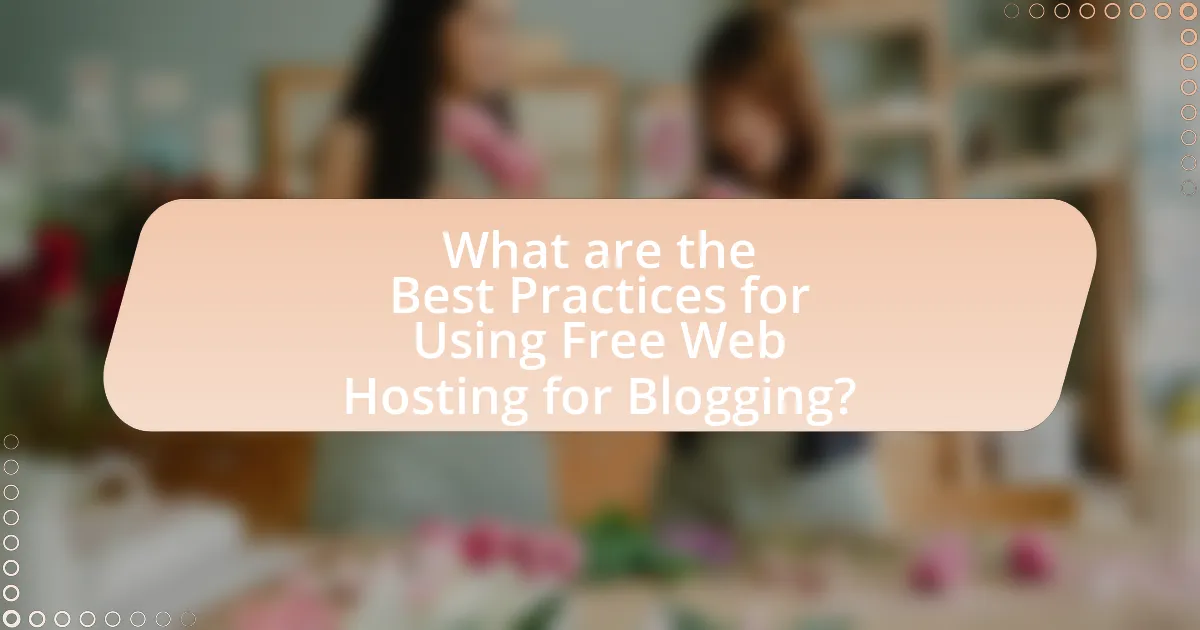Free web hosting for blogging is a cost-effective solution that allows individuals to create and publish blogs online without financial investment. This article explores the differences between free and paid hosting, highlighting the limitations of free services, such as restricted storage and bandwidth, lack of customer support, and potential impacts on blog performance. It also discusses the advantages of free hosting, including accessibility for beginners and essential tools for content creation. Additionally, the article provides guidance on selecting a reliable provider, optimizing blog performance, and best practices for managing a blog on free hosting platforms.

What is Free Web Hosting for Blogging?
Free web hosting for blogging is a service that allows individuals to create and publish blogs online without incurring any costs for hosting their website. This type of hosting typically provides limited storage, bandwidth, and features compared to paid hosting options, but it enables users to start blogging without financial investment. Many platforms, such as WordPress.com and Blogger, offer free web hosting, allowing users to access essential tools for content creation and site management.
How does free web hosting differ from paid hosting?
Free web hosting differs from paid hosting primarily in terms of features, reliability, and support. Free hosting typically offers limited storage, bandwidth, and lacks essential features such as custom domain names and professional email accounts, while paid hosting provides greater resources, enhanced performance, and additional services like customer support and security features. For instance, a study by HostingAdvice in 2021 indicated that paid hosting services generally have 99.9% uptime guarantees, compared to free hosting options that often experience frequent downtimes and slower loading speeds.
What are the limitations of free web hosting services?
Free web hosting services have several limitations, including restricted storage space, limited bandwidth, lack of customer support, and the presence of advertisements. These services typically offer minimal storage, often less than 1 GB, which can hinder the ability to host multiple or large files. Bandwidth limitations can restrict the number of visitors a site can handle, potentially leading to downtime during peak traffic. Additionally, free hosting often lacks reliable customer support, making it difficult for users to resolve issues promptly. Furthermore, many free hosting providers display ads on users’ websites, which can detract from the site’s professionalism and user experience.
How can free web hosting impact blog performance?
Free web hosting can significantly impact blog performance by limiting speed, reliability, and customization options. Blogs hosted on free platforms often experience slower loading times due to shared resources, which can lead to higher bounce rates; studies show that a one-second delay in page load time can reduce conversions by 7%. Additionally, free hosting services may have frequent downtimes, affecting accessibility and user experience. Furthermore, these platforms typically offer limited storage and bandwidth, restricting the ability to grow and manage content effectively. Lastly, customization options are often minimal, hindering the ability to optimize the blog for search engines, which can negatively affect visibility and traffic.
Why choose free web hosting for blogging?
Free web hosting is often chosen for blogging due to its cost-effectiveness, allowing users to start their blogs without financial investment. This accessibility enables new bloggers to experiment with their ideas and build an audience without the burden of hosting fees. According to a survey by Statista, as of 2021, 43% of bloggers reported using free platforms to launch their blogs, highlighting the popularity of this option among beginners. Additionally, free web hosting services typically provide user-friendly interfaces and templates, making it easier for individuals with limited technical skills to create and manage their blogs effectively.
What are the advantages of using free web hosting?
Free web hosting offers several advantages, primarily cost savings, as it allows users to create and maintain a website without incurring any financial expenses. This is particularly beneficial for beginners or small businesses that may have limited budgets. Additionally, free web hosting services often provide user-friendly interfaces and templates, making it easier for individuals with little technical expertise to set up their blogs quickly. Many free hosting platforms also include built-in tools for website management, analytics, and basic SEO, which can enhance the user experience and improve site visibility. Furthermore, free web hosting can serve as a testing ground for new ideas or projects, allowing users to experiment without financial risk.
Who can benefit the most from free web hosting?
Individuals and small businesses can benefit the most from free web hosting. These users often have limited budgets and seek to establish an online presence without incurring costs. Free web hosting provides essential features such as website creation tools and basic storage, allowing them to launch blogs or personal websites. According to a 2021 survey by Statista, 30% of small businesses reported using free hosting services to test their ideas before investing in paid options, demonstrating the practicality of free hosting for those starting out.

How to Get Started with Free Web Hosting?
To get started with free web hosting, choose a reputable provider that offers free hosting services, such as InfinityFree or 000webhost. These platforms typically allow users to create a website without any cost, providing essential features like a website builder, limited storage, and bandwidth. For instance, InfinityFree offers unlimited disk space and bandwidth, making it suitable for beginners. After selecting a provider, sign up for an account, follow the setup instructions, and upload your website files or use their website builder to create your blog.
What steps should you follow to set up a blog on free web hosting?
To set up a blog on free web hosting, follow these steps: First, choose a free web hosting provider such as WordPress.com, Blogger, or Wix. Next, create an account by providing your email and setting a password. After account creation, select a blog template or theme that suits your style. Then, customize your blog by adding a title, description, and any necessary widgets or plugins. Finally, start creating content by writing posts and publishing them on your blog. These steps are validated by the widespread use of platforms like WordPress.com, which hosts millions of blogs for free, demonstrating the effectiveness of this process.
How do you select the right free web hosting provider?
To select the right free web hosting provider, evaluate the provider’s reliability, features, and support options. Reliable providers typically offer uptime guarantees of 99.9% or higher, ensuring your blog remains accessible. Features to consider include storage space, bandwidth limits, and the availability of website builders or content management systems. Additionally, assess the level of customer support, as responsive assistance can be crucial when issues arise. Researching user reviews and comparisons can further validate your choice, as many users share their experiences regarding performance and service quality.
What are the essential features to look for in a free web host?
The essential features to look for in a free web host include storage space, bandwidth, uptime reliability, customer support, and ease of use. Storage space determines how much content you can host, while bandwidth affects the amount of data transferred to visitors. Uptime reliability is crucial, as a host with 99.9% uptime ensures your blog remains accessible. Customer support is important for resolving issues quickly, and ease of use allows for straightforward site management. These features collectively enhance the performance and reliability of your blogging experience on a free web host.
How can you register a domain with free web hosting?
To register a domain with free web hosting, first select a free web hosting provider that offers domain registration services, such as InfinityFree or 000webhost. After choosing the provider, create an account and follow their registration process, which typically includes entering your desired domain name and completing any required verification steps. Many free hosting services allow you to register a subdomain at no cost, while some may offer a free domain for the first year with certain conditions. This process is valid as numerous free hosting platforms provide these options to attract users.
What are the options for domain registration with free hosting?
Options for domain registration with free hosting include using subdomains provided by free hosting services, such as WordPress.com or Wix, which allow users to create a website without purchasing a separate domain. Additionally, some platforms like InfinityFree or 000webhost offer free hosting with the option to register a custom domain at a low cost. These services typically provide basic features suitable for personal blogs or small projects. The availability of free subdomains and low-cost custom domains makes it feasible for users to establish an online presence without significant financial investment.
How does a subdomain work in free web hosting?
A subdomain in free web hosting functions as an extension of the main domain, allowing users to create separate sections of their website without needing a unique domain name. For example, if the main domain is “example.com,” a subdomain could be “blog.example.com.” Free web hosting services typically provide users with a subdomain as part of their hosting package, enabling them to host their content under a recognizable brand without incurring additional costs. This structure is beneficial for organizing content, as it allows for distinct areas of a website, such as blogs, forums, or portfolios, while still being associated with the primary domain.

What are the Best Practices for Using Free Web Hosting for Blogging?
The best practices for using free web hosting for blogging include selecting a reliable provider, optimizing for SEO, and regularly backing up content. Reliable providers, such as WordPress.com or Blogger, offer user-friendly interfaces and essential features. Optimizing for SEO involves using relevant keywords, creating quality content, and ensuring mobile responsiveness, which can enhance visibility and traffic. Regular backups are crucial because free hosting services may have limited support and can lead to data loss. According to a 2021 survey by HostingAdvice, 70% of users experienced downtime with free hosting, emphasizing the importance of choosing a dependable service and maintaining backups.
How can you optimize your blog on free web hosting?
To optimize your blog on free web hosting, focus on improving loading speed, enhancing SEO, and utilizing available features effectively. Loading speed can be improved by compressing images and minimizing the use of heavy scripts, which is crucial as studies show that a one-second delay in page load time can lead to a 7% reduction in conversions. For SEO, use relevant keywords in your content, titles, and meta descriptions, as search engines prioritize well-optimized content. Additionally, leverage any built-in tools provided by the free hosting service, such as analytics and social media integration, to track performance and engage with your audience effectively.
What strategies can improve loading speed on free hosting?
To improve loading speed on free hosting, optimizing images is essential. Large image files can significantly slow down page load times, so using compressed formats like JPEG or PNG and reducing dimensions can enhance performance. Additionally, leveraging browser caching allows frequently accessed resources to be stored locally on users’ devices, reducing load times on subsequent visits. Implementing a Content Delivery Network (CDN) can also distribute content across multiple servers, decreasing latency for users in different geographical locations. Furthermore, minimizing HTTP requests by combining CSS and JavaScript files can streamline the loading process. These strategies collectively contribute to a more efficient loading speed on free hosting platforms.
How can you enhance security for your blog on free hosting?
To enhance security for your blog on free hosting, implement strong passwords and enable two-factor authentication. Strong passwords reduce the risk of unauthorized access, while two-factor authentication adds an additional layer of security by requiring a second form of verification. According to a study by Verizon, 81% of data breaches are linked to weak or stolen passwords, highlighting the importance of robust password practices. Additionally, regularly updating your blog software and plugins can protect against vulnerabilities, as outdated systems are often targeted by attackers.
What common challenges might you face with free web hosting?
Common challenges with free web hosting include limited storage and bandwidth, lack of customer support, and potential security vulnerabilities. Free web hosting services often impose strict limits on storage space and bandwidth, which can hinder a blog’s growth and performance. Additionally, these services typically offer minimal or no customer support, making it difficult for users to resolve issues promptly. Security is another concern, as free hosting providers may not implement robust security measures, leaving websites vulnerable to attacks. These challenges can significantly impact the reliability and professionalism of a blog hosted on a free platform.
How can you troubleshoot downtime issues on free hosting?
To troubleshoot downtime issues on free hosting, first check the hosting provider’s status page for any reported outages. Many free hosting services have a status page that provides real-time updates on server health and maintenance schedules. If no outages are reported, verify your internet connection to ensure that the issue is not on your end. Additionally, clear your browser cache and cookies, as corrupted data can sometimes prevent access to your site.
If the problem persists, access your hosting control panel to review any error messages or logs that may indicate the cause of the downtime. Look for resource limits, such as bandwidth or storage, that may have been exceeded, as free hosting often comes with strict limitations. If necessary, reach out to the hosting provider’s support team for assistance, as they can provide insights specific to their service.
These steps are effective because they address common causes of downtime and utilize available resources to diagnose the issue.
What are the best ways to handle limited storage and bandwidth?
To handle limited storage and bandwidth effectively, utilize content optimization techniques. Compress images and files to reduce their size, which can significantly save storage space and bandwidth usage. Implement caching strategies to minimize data transfer by storing frequently accessed content locally. Additionally, use a Content Delivery Network (CDN) to distribute content efficiently, reducing the load on your primary server and improving access speed for users. According to a study by Akamai, using a CDN can improve load times by up to 50%, demonstrating its effectiveness in managing bandwidth.
What tips can help you succeed with free web hosting for blogging?
To succeed with free web hosting for blogging, choose a reliable provider that offers sufficient bandwidth and storage. Reliable providers like WordPress.com and Blogger have established reputations for uptime and user support, which are crucial for maintaining a consistent blogging experience. Additionally, optimize your blog’s content for search engines by using relevant keywords and engaging titles, as this can significantly increase visibility and traffic. According to a study by HubSpot, 75% of users never scroll past the first page of search results, highlighting the importance of SEO. Lastly, regularly update your blog with fresh content to keep your audience engaged and encourage repeat visits, as consistent posting can lead to higher reader retention rates.
How can you effectively promote your blog hosted on a free platform?
To effectively promote your blog hosted on a free platform, utilize social media channels to share your content and engage with your audience. Social media platforms like Facebook, Twitter, and Instagram have billions of active users, providing a vast audience for your blog. By creating shareable posts and using relevant hashtags, you can increase visibility and drive traffic to your blog. Additionally, participating in online communities and forums related to your blog’s niche can help you connect with potential readers and share your expertise, further promoting your content.
What are the key metrics to track for a blog on free hosting?
The key metrics to track for a blog on free hosting include traffic, engagement, bounce rate, and conversion rate. Traffic measures the number of visitors to the blog, indicating its reach and popularity. Engagement, often assessed through comments, shares, and time spent on the site, reflects how well the content resonates with the audience. Bounce rate indicates the percentage of visitors who leave the site after viewing only one page, providing insight into content effectiveness and user experience. Conversion rate tracks the percentage of visitors who complete a desired action, such as signing up for a newsletter or making a purchase, demonstrating the blog’s ability to drive user actions. These metrics are essential for evaluating the blog’s performance and guiding improvements.